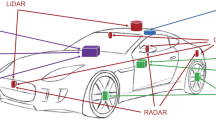Abstract
Current localization techniques in outdoors cannot work well in indoors. Wi-Fi fingerprinting technique is an emerging localization technique for indoor environments. However in this technique, the dynamic nature of WiFi signals affects the accuracy of the measurements. In this paper, we use affinity propagation clustering method to decrease the computation complexity in location estimation. Then, we use the least variance of Received Signal Strength (RSS) measured among Access Points (APs) in each cluster. Also we assign lower weights to altering APs for each point in a cluster, to represent the level of similarity to Test Point (TP) by considering the dynamic nature of signals in indoor environments. A method for updating the radio map and improving the results is then proposed to decrease the cost of constructing the radio map. Simulation results show that the proposed method has 22.5% improvement in average in localization results, considering one altering AP in the layout, compared to the case when only RSS subset sampling is considered for localization because of altering APs.








Similar content being viewed by others
References
He, S., & Chan, S.-H. G. (2016). Wi-Fi fingerprint-based indoor positioning: Recent advances and comparisons. IEEE Communications Surveys and Tutorials, 18(1), 466–490.
Munoz, D., Lara, F. B., Vargas, C., & Enriquez-Caldera, R. (2009). Position location techniques and applications. New York: Academic Press.
Harroud, H., Ahmed, M., & Karmouch, A. (2003). Policy-driven personalized multimedia services for mobile users. IEEE Transactions on Mobile Computing, 2(1), 16–24.
Molina, B., Olivares, E., Palau, C. E., & Esteve, M. (2018). A multimodal fingerprint-based indoor positioning system for airports. IEEE Access, 6, 10092–10106.
Rodriguez, M. D., Favela, J., Martínez, E. A., & Muñoz, M. A. (2004). Location-aware access to hospital information and services. IEEE Transactions on Information Technology in Biomedicine, 8(4), 448–455.
Misra, P., & Enge, P. (1999). Special issue on global positioning system. Proceedings of the IEEE, 87(1), 3–15.
Raquet, J., & Martin, R. K. (2008). Non-GNSS radio frequency navigation. In IEEE international conference on acoustics, speech and signal processing (ICASSP) (pp. 5308–5311).
Vo, Q. D., & De, P. (2016). A survey of fingerprint-based outdoor localization. IEEE Communications Surveys and Tutorials, 18(1), 491–506.
Bahl, P., & Padmanabhan, V. N. (2000). RADAR: An in-building RF-based user location and tracking system. In INFOCOM 2000. Nineteenth annual joint conference of the IEEE computer and communications societies. Proceedings. (pp. 775–784).
Moghtadaiee, V., & Dempster, A. G. (2014). Indoor location fingerprinting using FM radio signals. IEEE Transactions on Broadcasting, 60(2), 336–346.
Liu, Y., Dashti, M., Rahman, M. A. A., & Zhang, J. (2014). Indoor localization using smartphone inertial sensors. In Positioning, navigation and communication (WPNC). (pp. 1–6).
Alikhani, N., Amirinanloo, S., Moghtadaiee, V., & Ghorashi, S. A. (2017). Fast fingerprinting based indoor localization by Wi-Fi signals. In International conference on computer and knowledge engineering (ICCKE) (pp. 241–246).
Khalajmehrabadi, A., Gatsis, N., & Akopian, D. (2017). Modern WLAN fingerprinting indoor positioning methods and deployment challenges. IEEE Communications Surveys and Tutorials, 19(3), 1974–2002.
He, S., Ji, B., & Chan, S.-H. G. (2016). Chameleon: Survey-free updating of a fingerprint database for indoor localization. IEEE Pervasive Computing, 15(4), 66–75.
He, S., Lin, W., & Chan, S.-H. G. (2017). Indoor localization and automatic fingerprint update with altered AP signals. IEEE Transactions on Mobile Computing, 16(7), 1897–1910.
Han, S., Zhao, C., Meng, W., & Li, C. (2015). Cosine similarity based fingerprinting algorithm in WLAN indoor positioning against device diversity. In International conference on communications (ICC) (pp. 2710–2714).
Wang, B., Chen, Q., Yang, L. T., & Chao, H.-C. (2016). Indoor smartphone localization via fingerprint crowdsourcing: Challenges and approaches. IEEE Wireless Communications, 23(3), 82–89.
Frey, B. J., & Dueck, D. (2007). Clustering by passing messages between data points. Science, 315(5814), 972–976.
Fu, Y., Chen, P., Yang, S., & Tang, J. (2018). An indoor localization algorithm based on continuous feature scaling and outlier deleting. IEEE Internet of Things Journal, 5(2), 1108–1115.
Huang, J., Millman, D., Quigley, M., Stavens, D., Thrun, S., & Aggarwal, A. (2011). Efficient, generalized indoor wifi graphslam. In International conference on robotics and automation (ICRA) (pp. 1038–1043).
Yoo, S., Kim, E., & Kim, H. (2014). Exploiting user movement direction and hidden access point for smartphone localization. Wireless Personal Communications, 78(4), 1863–1878.
Ferris, B. D., Fox, D., & Lawrence, N. (2007). WiFi-SLAM using Gaussian process latent variable models.
Yin, J., Yang, Q., & Ni, L. M. (2008). Learning adaptive temporal radio maps for signal-strength-based location estimation. IEEE Transactions on Mobile Computing, 7(7), 869–883.
Atia, M. M., Noureldin, A., & Korenberg, M. J. (2013). Dynamic online-calibrated radio maps for indoor positioning in wireless local area networks. IEEE Transactions on Mobile Computing, 12(9), 1774–1787.
Fallah, M., & Pourahmadi, V. (2018). Graph-based iterative measurement-denoising and radio-map generation for semi-supervised indoor localisation. IET Communications, 12(7), 848–853.
Cormen, T. H., Leiserson, C. E., Rivest, R. L., & Stein, C. (2009). Introduction to algorithms. New York: MIT Press.
Roos, T., Myllymäki, P., Tirri, H., Misikangas, P., & Sievänen, J. (2002). A probabilistic approach to WLAN user location estimation. International Journal of Wireless Information Networks, 9(3), 155–164.
Kushki, A., Plataniotis, K. N., & Venetsanopoulos, A. N. (2007). Kernel-based positioning in wireless local area networks. IEEE Transactions on Mobile Computing, 6, 689–705.
Acknowledgements
Vahideh Moghtadaiee gratefully acknowledges the support provided by the Iran National Science Foundation (INSF) for this work.
Author information
Authors and Affiliations
Corresponding author
Additional information
Publisher's Note
Springer Nature remains neutral with regard to jurisdictional claims in published maps and institutional affiliations.
Rights and permissions
About this article
Cite this article
Alikhani, N., Moghtadaiee, V. & Ghorashi, S.A. Fingerprinting Based Indoor Localization Considering the Dynamic Nature of Wi-Fi Signals. Wireless Pers Commun 115, 1445–1464 (2020). https://doi.org/10.1007/s11277-020-07636-0
Published:
Issue Date:
DOI: https://doi.org/10.1007/s11277-020-07636-0




